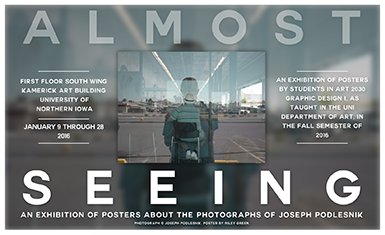 |
| David Suter Poster | Kaycee Miller 2016 |
A two-day campus visit by the artist took place on October 24-25, 2016,at the University of Northern Iowa. Sponsored by the UNI Department of Art, the event was part of the Meryl Norton Hearst Lecture Series.
Suter's editorial illustrations have been described as "puzzles and mindbogglers, tricks of the subconscious, and foolers of the eye." Some people call them visual puns or metaphors, but the artist prefers "to think of them as equations…It's a little like algebra. I try to combine two images through a process of finding similarities and canceling out dissimilar aspects."
Concurrent with David Suter's campus visit, there were exhibits of his OpEd drawings and of a series of posters (including the one shown here) by UNI graphic design students that celebrated his drawings.
•••
Frank Swinnerton, Swinnerton: An Autobiography. Garden City NY: Doubleday, Doran and Company, 1936, p. 28-29 [recalling the bullying he observed in a school that he attended in London]—
All [six boy] pupils were taught in the same room [and were largely unsupervised]…two horrid little devils declared a vendetta against the only other boy of roughly their own size, the spectacle of which moved me to such helpless rage that in thinking of it now I still feel embarrassed distaste. While the master was there these wretches did no more than stick lighted matches into the boy's tweed coat. When the master was away, as he often was, they had greater liberty, of which they took instant advantage. They wrenched their enemy's arms, speared, pinched, and kicked him until his shins must have been black and his flesh purple; and at last forced his head murderously back over desks and parallel bars until he became blue in the face. It was appalling. I was too weak to lend an effective aid; the boy was too plucky to tell tales and was not strong enough to resist such implacable foes; and these foes grew every day more and more reckless, more and more outrageously brutal. At last, when he was being tortured one morning to the limit of endurance, I (a sort of Sister Anne at the window) caught sight of the master without, frantically summoned him by means of a wild rapping on the pane, and so brought the horror to an end.
• The drawing in the poster is the copyright of David Suter. All rights reserved.



































